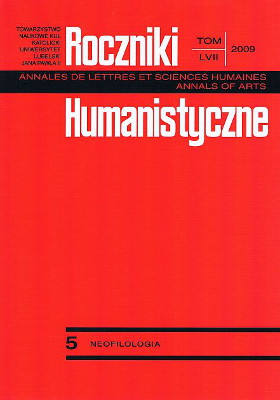Element Interactions at Domain Edges
Abstract
[Abstrakt tylko w j. polskim / Abstract only in Polish]
Interakcje międzysegmentowe na granicy domen morfologicznych
Artykuł porusza tematykę związaną z istnieniem zjawisk językowych pomiędzy dźwiękami na granicy domen morfologicznych. Autorka podejmuje próbę przybliżenia podejścia do analizy interakcji międzysegmentowych, jakie proponuje niederywacyjny model Fonologii Rządu. Zdefiniowane zostają zatem takie pojęcia formalne jak: domena fonologiczna, segment, element oraz trzy podstawowe typy relacji czy też oddziaływań pomiędzy dźwiękami. Są to relacja dzielenia się elementami, rozprzestrzeniania się elementów raz połączeń mostowych. Każda z tych relacji wymaga spełnienia odmiennych warunków, aby zaistnieć w obrębie domeny fonologicznej, oraz skutkuje innymi konsekwencjami dla struktury segmentów. Materiał badawczy, który służy do zilustrowania wspomnianych zjawisk, pochodzi z języka angielskiego oraz irlandzkiego. Rozważania zamieszczone w artykule mają charakter ogólny, a ich celem jest uwypuklenie roli, jaką w fonologii odgrywa informacja morfologiczna, zwłaszcza dotycząca rodzaju granicy między sąsiadującymi morfemami.
References
Bloch-Rozmej, A. (1997). ‘Nasal vowels in Polish.’ Papers and Studies in Contrastive Linguistics 32, 81-103.
Bloch-Rozmej, A. (1998). Element interactions in phonology. A study in Connemara Irish. Lublin: Redakcja Wydawnictw KUL.
Bloch-Rozmej, A. (2008a). Melody in Government Phonology. Lublin: Wydawnictwo KUL.
Bloch-Rozmej, A. (2008b in press). ‘Bridging and the phonology-morphology interface.’ To appear in Zeszyty Naukowe KUL, Lublin.
Brockhaus, W. (1995a). ‘Final devoicing in the phonology of German.’ Linguistische Arbeiten 336. Tübingen: Niemeyer.
Brockhaus, W. (1995b). ‘Skeletal and suprasegmental structure within Government Phonology.’ In: J. Durand and F. Katamba, (eds.), Frontiers of phonology. Atoms, structures, derivations. London: Longman.
Charette, M. (1991). Conditions on phonological government. Cambridge: Cambridge University Press.
Cyran, E. (1997). Resonance elements in phonology. A study in Munster Irish. PASE Studies and Monographs, vol. 3. Lublin: Wydawnictwo Folium.
Cyran, E. ed., (1998). Structure and interpretation. Studies in phonology. Lublin: Folium.
Cyran, E. (2003). Complexity scales and licensing strength in phonology. Lublin: Wydawnictwo KUL.
Foclóir Póca. English-Irish, Irish-English Dictionary (1992) An Gúm, Baile Átha Cliath.
Gussmann, E. (2002). Phonology: analysis and theory. Cambridge: Cambridge University Press.
Gussmann, E. (2007). The phonology of Polish. Oxford: Oxford University Press.
Harris, J. (1990). ‘Segmental complexity and phonological government.’ Phonology 7, 255-300.
Harris, J. (1994). English Sound Structure. Oxford: Blackwell.
Harris, J. (1997). ‘Licensing Inheritance: an integrated theory of neutralisation.’ Phonology 14, 315-370.
Harris, J. and G. Lindsey (1995). ‘The elements of phonological representation.’ In: J. Durand and F. Katamba (eds.), Frontiers of phonology. Atoms, structures, derivations. London: Longman, 34–79.
Jaskuła, K. (2008). ‘The origins of Celtic lenition.’ In: A. Bloch-Rozmej (ed.), Issues in Celtic Linguistics. Lublin: Wydawnictwo KUL.
Kaye, J. (1990). ‘Coda’ Licensing. Phonology 7, 301–330.
Kaye, J., Lowenstamm, J. and Vergnaud, J. R. (1990). ‘Constituent structure and government in phonology.’ Phonology 7, 193–231.
Ó Siadhail, M. (1988). Learning Irish. Dublin: The Dublin Institute for Advanced Studies.
Ó Siadhail, M. (1989). Modern Irish. Grammatical structure and dialectal variation. Cambridge: Cambridge University Press.
Ploch, S. (2003a) Can “phonological” nasality be derived from phonetic nasality? In J. van de Weijer, V. J. van Heuven, and H. van der Hulst (eds.), The Phonological Spectrum. Segmental Structure, Vol. I. Amsterdam: John Benjamins 73-116.
Ploch, S., ed. (2003b) Living on the Edge, 28 papers in honour of Jonathan Kaye. Berlin, New York: Mouton de Gruyter.
Scheer, T. (2004). A lateral theory of phonology: what is CVCV, and why should it be? Berlin: Mouton de Gruyter.
Wells, J. C. (1990). Longman Pronunciation Dictionary. London: Longman.
Copyright (c) 2009 Roczniki Humanistyczne

This work is licensed under a Creative Commons Attribution-NonCommercial-NoDerivatives 4.0 International License.





